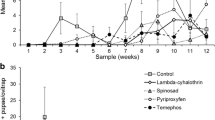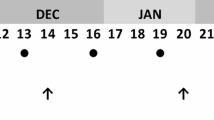Abstract
Dengue vector control programmes are mainly focused on insecticide fogging/ space spraying to control adult Aedes mosquito vector populations. Due to the diurnal habit of the vectors, spraying is routinely conducted during the day when many other insect species are also active. This study reports the simultaneous effect of fogging on non-target insects by direct counting of knockdown in the insect population. Eight fogging treatments were conducted in two sites in Kurunegala District of Sri Lanka. Pesguard insecticide was sprayed in each treatment for 8 minutes according to the standard methodology and the ‘knockdown insects’ were collected on randomly spread polyethythene sheets (10 m2). A total of 3884 insects (24.3 insects per treatment per m2 belonging to 12 orders were collected and 12.44% of them recovered during a 24-hr recovery period. Diptera was the most affected insect order (36%) followed by Collembola (30%) and Thysanoptera (17%). Out of the 31 mosquitoes (<1%) collected, only two (<0.1%) belonged to the genus Aedes. Body length of 93% of the affected insects ranged from 0.35 mm to 1.8 mm. Positive controls using the WHO standard cage bioassays with the mosquito Ae. albopictus (n = 417) and the stingless bee Trigona iridipennis (n = 122) showed 100% initial knockdown, and 83.5% mosquito and 93.5% bee mortalities after the recovery period. The study shows that insecticide fogging does have a severe effect on non-target insects such as pollinators; therefore, fogging operations should be done in a controlled manner and indiscriminate fogging should be avoided.
Similar content being viewed by others
References
Appanah, S. and Chan, H. T. (1981) Thrips: the pollinators of some dipterocarps. Malaysian Forester 44, 234–252.
Bambaradeniya, C. and Edirisinghe, J. (2008) Composition, structure and dynamics of arthropod communities in a rice agro-ecosystem. Ceylon Journal of Science (Biological Sciences) 37, 23–48. doi: 10.4038/cjsbs.v37i1.494.
Bingham, C. T. (1897) Fauna of British India, including Ceylon and Burma: Hymenoptera–V.1–Wasps and Bees. Taylor and Francis, London. 608 pp.
Bland, R. G. and Jaques, H. E. (1984) How to Know The Insects. W. C. Brown Company, Dubuque, Iowa. 409 pp.
Bonds, J. A. (2012) Ultra-low-volume space sprays in mosquito control: A critical review. Medical and Veterinary Entomology 26, 121–130. doi: 10.1111/j.1365-2915.2011.00992.x.
Boyce, W. M., Lawler, S. P., Schultz, J. M., McCauley, S. J., Kimsey, L. S., Niemela, M. K., Nielson, C. F. and Reisen, W. K. (2007) Nontarget effects of the mosquito adulticide pyrethrin applied aerially during a West Nile Virus outbreak in an urban California environment. Journal of the American Mosquito Control Association 23, 335–339.
Breidenbaugh, M. S. and de Szalay, F. A. (2010) Effects of aerial applications of naled on nontarget insects at Par-ris Island, South Carolina. Environmental Entomology 39, 591–599.
Castner, J. L. (2000) Photographic Atlas of Entomology and Guide to Insect Identifcation. Feline Press, Gainesville, FL. 172 pp.
Çilgi, T. and Jepson, P. C. (1995) The risks posed by del-tamethrin drift to hedgerow butterfies. Environmental Pollution 87, 1–9.
Daly, H. V., Doyen, J. T. and Purcell, A. H. (1998) Introduction to Insect Biology and Diversity. Oxford University Press, United Kingdom. 680 pp.
Dodge, H. R. (1953) Identifying common fies. Public Health Reports 68, 345–362.
Frye, R. D., Dix, M. E. and Carey, D. R. (1988) Effect of two insecticides on abundance of insect families associated with Siberian elm windbreaks. Journal of the Kansas Entomological Society 61, 278–284.
Holland, J. M., Winder, L. and Perry, J. N. (2000) The impact of dimethoate on the spatial distribution of benefcial arthropods in winter wheat. Annals of Applied Biology 136, 93–105.
Hunter, W. B. and Ullman, D. E. (1989) Analysis of mouthpart movements during feeding of Frankliniella occidentalis (Pergande) and F. schultzei Trybom (Thysanoptera: Thripidae). International Journal of Insect Morphology and Embryology 18, 161–171.
Karunaratne, W. A. I. P. and Edirisinghe, J. P. (2008) Keys to the identifcation of common bees of Sri Lanka. Journal of the National Science Foundation of Sri Lanka 36, 69–89. doi:10.4038/jnsfsr.v36i1.134.
Karunaratne, S. H. P. P., Weeraratne, T. C., Perera, M. D. and Surendran, S. N. (2013) Insecticide resistance and effc-acy of space spraying and larviciding in the control of dengue vectors Aedes aegypti and Aedes albopictus in Sri Lanka. Pesticide Biochemistry and Physiology 107, 98–105. doi: 10.1016/j.pestbp.2013.05.011.
Klironomos, J. N. and Moutoglis, P. (1999) Colonization of non mycorrhizal plants by mycorrhizal neighbours as infuenced by the collembolan, Folsomia candida. Biology and Fertility of Soils 29, 277–281.
Kwan, J. A., Novak, M. G., Hyles, T. S. and Niemela, M. K. (2009) Mortality of nontarget arthropods from an aerial application of pyrethrins. Journal of the American Mosquito Control Association 25, 218–220.
Lartey, R. T., Curl, E. A., Peterson, C. M. and Harper, J. D. (1989) Mycophagous grazing and food preference of Proisoto minuta (Collembola: Isotomidae) and Onychiurus encarpatus (Collembola: Onychiuridae). Environmental Entomology 18, 334–337.
Merritt, R. W. and Cummins, K. W. (Eds) (1996) An Introduction to the Aquatic Insects of North America, 3rd edition. Kendall Hunt Publishing Company, Dubuque, IA, USA. 862 pp.
Ministry of Health, Epidemiology Unit, Sri Lanka. (2014) Distribution of Notifcation (H399) Dengue Cases by Month, [online] Available at: https://doi.org/wwwwww.epid.gov.lk/web/index.php?option= com_casesanddeathss&Itemid=448&lang=en#. Accessed 12 October 2016.
Moreby, S. J., Sotherton, N. W. and Jepson, P. C. (1997) The effects of pesticides on species of non-target Heter-optera inhabiting cereal felds in Southern England. Pesticide Science 51, 39–48.
Ponge, J.F. (1991) Food resources and diets of soil animals in a small area of Scots pine litter. Geoderma 49, 33–62.
Sabatini, M. A. and Innocenti, G. (2001) Effects of Colle-mbola on plant–pathogenic fungus interactions in simple experimental systems. Biology and Fertility of Soils 33, 62–66. doi:10.1007/s003740000290.
Shiraishi, H., Enami, Y. and Okano, S. (2003) Folsomia hidakana (Collembola) prevents damping-off disease in cabbage and Chinese cabbage by Rhizoctonia solani. Pedobiologia 47, 33–38.
Thimm, T., Hoffmann, A., Borkott, H., Munch, J. C. and Tebbe, C. C. (1998) The gut of the soil microarthropod Folsomia candida (Collembola) is a frequently changeable but selective habitat and a vector for microorganisms. Applied and Environmental Microbiology 64, 2660–2669.
Weeraratne, T. C., Perera, M. D. B., Mansoor, M. A. C. M. and Karunaratne, S. H. P. P. (2013) Prevalence and breeding habitats of the dengue vectors Aedes aegypti and Aedes albopictus (Diptera: Culicidae) in the semi-urban areas of two different climatic zones in Sri Lanka. International Journal of Tropical Insect Science, 33(4), 216–226.
WHO [World Health Organization] (2003) Space Spray Application of Insecticides for Vector and Public Health Pest Control: A Practitioner’s Guide. WHO, Geneva, Switzerland.
Author information
Authors and Affiliations
Rights and permissions
About this article
Cite this article
Abeyasuriya, K.G.T.N., Nugapola, N.W.N.P., Perera, M.D.B. et al. Effect of dengue mosquito control insecticide thermal fogging on non-target insects. Int J Trop Insect Sci 37, 11–18 (2017). https://doi.org/10.1017/S1742758416000254
Accepted:
Published:
Issue Date:
DOI: https://doi.org/10.1017/S1742758416000254




